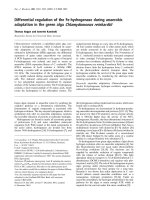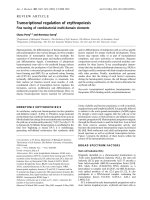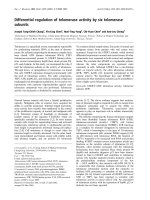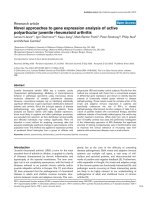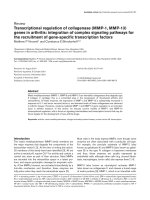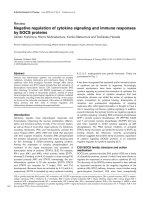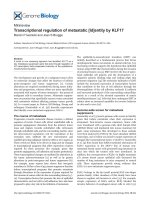Báo cáo y học: "Translational regulation of gene expression" docx
Bạn đang xem bản rút gọn của tài liệu. Xem và tải ngay bản đầy đủ của tài liệu tại đây (58.24 KB, 3 trang )
Genome Biology 2004, 5:359
comment
reviews
reports
deposited research
interactions
information
refereed research
Meeting report
Translational regulation of gene expression
Stephanie Kervestin and Nadia Amrani
Address: Department of Molecular Genetics and Microbiology, University of Massachusetts Medical School, Worcester, MA 01655-0122, USA.
Correspondence: Nadia Amrani. E-mail:
Published: 25 November 2004
Genome Biology 2004, 5:359
The electronic version of this article is the complete one and can be
found online at />© 2004 BioMed Central Ltd
A report on the Cold Spring Harbor Laboratory meeting
‘Translational Control’, Cold Spring Harbor, USA, 7-12
September 2004.
There have been major breakthroughs in recent years in
understanding both the mechanism of mRNA translation
and its control. High-resolution structures have revealed the
ribosome’s role in the decoding process and the ribozyme
activity of its peptidyl transferase center. The importance of
post-transcriptional mechanisms in the regulation of gene
expression is also much better appreciated today. The 2004
Cold Spring Harbor ‘Translational Control’ meeting
addressed a variety of these mechanisms and provided new
insights into the regulatory roles of RNA elements and RNA-
binding protein complexes.
Ribosomal structure and the mechanism of
translation
The crystal structures of ribosomes published in the past few
years have revolutionized our understanding of the struc-
tural basis of tRNA selection and the peptide-bond-forming
activity of the ribosome. The precise mechanisms of the dis-
tinct steps of protein synthesis are still unknown, however.
This issue was addressed by several speakers, including
Venki Ramakrishnan (MRC Laboratory of Molecular
Biology, Cambridge, UK), who presented his recent work
showing that the ribosome promotes accurate tRNA selec-
tion at the ribosomal A site and that recognition of cognate
codon-anticodon interaction induces the 30S ribosome
subunit to adopt a closed conformation. This movement
most probably accelerates the rate of GTP hydrolysis and the
following accommodation step, observed by other groups
from kinetic analysis. Other presentations focused on struc-
tural rearrangements of the ribosome during elongation and
translocation and, together, these structural data highlighted
the dynamic nature of ribosome structure during the differ-
ent steps of translation and prompted the audience to
ponder which conformational changes are rate-limiting
during translation.
Structural analysis of the eukaryotic ribosome when associ-
ated with translation factors has also brought new insights.
In eukaryotes, initiation of translation is generally depen-
dent on the presence of a 5Ј cap structure on the messenger
RNA. Cap-dependent translation initiation is a complex
process, facilitated by a large number of initiation factors
(eIFs) that form a complicated network of cooperative inter-
actions with the 40S ribosomal subunit. John McCarthy
(Manchester Interdisciplinary Biocentre, UK) reported cryo-
electron microscopy (cryo-EM) reconstructions, which indi-
cate that binding of eIF1A to the 40S ribosomal subunit
induces significant conformational changes in the subunit.
These movements may create a recruitment-competent state
of the 40S subunit that mediates the cooperative binding of
other eIFs to form the 43S initiation complex. Moreover, the
structure of the 43S complex indicates that the 40S to 43S
transition involves a large rotation of the head of the small
subunit; this is thought to reflect the opening of the mRNA
channel which, in turn, may facilitate mRNA binding and
subsequent scanning.
The cap-independent pathway of translation initiation, uti-
lized by both viral and cellular mRNAs, exploits highly struc-
tured translation-initiation regions on mRNAs dubbed
internal ribosome entry sites (IRESs). The IRES from the
cricket paralysis virus (CrPV) directly assembles elongation-
competent ribosomes in the absence of the canonical eIFs
and the initiator tRNA, methionyl-tRNA
i
. Eric Jan, from
Peter Sarnow’s group (Stanford University, USA) described
experiments exploiting cryo-EM to visualize the CrPV-IRES
bound to human 40S subunits and the 80S ribosome. The
IRES was shown to form specific contacts with the compo-
nents of the ribosomal A, P and E sites and to induce confor-
mational changes in the ribosome. These changes were
similar to those observed when the hepatitis C virus (HCV)
IRES binds to the 40S subunit and when the elongation
factor eEF2 binds to the 80S ribosome. This suggests that
the CrPV IRES functions as an RNA-based translation factor
that actively manipulates the ribosome to mediate the virus’s
unusual mode of translation initiation. Collectively, the
structural data on the ribosome and its associated complexes
presented during the meeting led the audience to an appreci-
ation of the ribosome as a dynamic machine whose contor-
tions are subject to the considerable influence of both
regulatory proteins and RNA structures.
Regulation of mRNA utilization by cis elements
and trans-acting factors
The expression of many proteins is influenced by the struc-
ture and cellular localization of their mRNAs, features often
dictated by specific RNA-binding proteins. Several talks and
posters addressed the functions of these RNA-binding trans-
lational activators and repressors, as well as the intricacies of
their RNA targets. One of the best characterized models of
translational control involving cis-acting RNA elements is
the regulation of translation of maternally inherited mRNA
by cytoplasmic polyadenylation in Xenopus oocytes.
Polyadenylation is required before the mRNA can be trans-
lated, and regulation of this step is therefore necessary for
oocyte maturation and embryonic development. Cytoplas-
mic polyadenylation depends on phosphorylation of CPEB, a
protein that is bound to specific cytoplasmic polyadenylation
elements (CPEs) in the 3Ј ends of transcripts regulated in
this manner. In Xenopus, phosphorylation is mediated by
the protein kinases Eg2 (known as Aurora A in the mouse)
and Cdc2. The role of the CPEs in the timing of polyadenyla-
tion and translational activation was addressed by Raul
Mendez (Center for Genomic Regulation, Barcelona, Spain).
He showed that the CPEs in the 3Ј untranslated regions
(UTRs) of the mRNAs of cyclins B1 through B5 regulate
translation of these mRNAs in a sequential manner during
Xenopus oocyte maturation. The presence of one CPE close
to, but not overlapping with, the hexanucleotide sequence
AAUAAA was shown to promote early polyadenylation, and
thus to stimulate translation, while the presence of a cluster
of CPEs in which one overlapped the AAUAAA sequence (or
was separated from it by only one to three nucleotides) pro-
moted repression of translation and late polyadenylation.
Sequence elements in UTRs can also enhance translation.
Eva Harris (University of California, Berkeley, USA) showed
that the 5Ј and 3Ј UTRs in dengue virus RNA can act
together to promote translation. Dengue RNA has a 5Ј m
7
G
cap and a non-polyadenylated 3Ј UTR, and undergoes cap-
dependent translation. But Harris showed that, under condi-
tions in which cap-dependent translation is inhibited,
cap-independent translation occurs, and that this mechanism
is distinct from IRES-driven activity and requires both the
5Ј and 3Ј UTRs. This shows for the first time that translation
initiation in a viral system can switch from being cap-
dependent to cap-independent, a property previously
described only for cellular mRNAs.
RNA-binding proteins have key roles in the regulation of
nearly every aspect of gene expression. They often display a
modular architecture, exert multiple functions and partici-
pate in more than one step of the gene-expression pathway.
Stefan Hüttelmaier, from the laboratory of Robert Singer
(Albert Einstein College of Medicine, New York, USA),
described how the trans-acting factor zipcode-binding
protein 1 (ZBP1), which binds to the 3Ј UTR of -actin
mRNA, regulates not only the localization of this mRNA in
fibroblasts and neurons, but also its translation. He showed
that binding of ZBP1 probably inhibits translation by inter-
fering with the formation of the 80S ribosome during initia-
tion. Two different pathways for phosphorylating ZBP1 are
involved in this regulation. Serine phosphorylation of ZBP1
by extracellular-regulated kinases (ERKs) induces repres-
sion of translation. In contrast, tyrosine phosphorylation of
ZBP1 by Src kinases inhibits its binding to RNA, thus antag-
onizing the repression.
In addition to being part of the translation machinery, some
ribosomal proteins have roles in translational control. Paul
Fox (Lerner Research Institute, Cleveland, USA) reported
the identification of ribosomal protein L13a as a component
of the GAIT complex. This complex binds to a previously
identified stem-loop structure in the 3Ј UTR of ceruloplas-
min mRNA, and is responsible for silencing its translation in
macrophages associated with inflammation. Fox showed
that, when L13a is phosphorylated, it is released from its site
in the 60S ribosomal subunit to form, with three other pro-
teins, the functional GAIT complex that binds to ceruloplas-
min mRNA and blocks its translation.
In a related vein, Jayati Sengupta from Joachim Frank’s lab
(The Howard Hughes Medical Institute at the Wadsworth
Center, Albany, USA), in collaboration with Poul Nissen’s
group (University of Aarhus, Denmark), described the iden-
tification and visualization of the protein RACK1 as a compo-
nent of the small ribosomal subunit in the fungus
Thermomyces lanuginosus. RACK1 (also called Asc1p in
Saccharomyces cerevisiae) acts as a scaffold for recruiting
proteins involved in signaling pathways and has been linked
to the control of translation initiation of specific mRNAs.
Cryo-EM density maps of purified wild-type 80S ribosomes
were compared with those of ribosomes from mutant cells
lacking RACK1. This showed that RACK1 is located on the
head region of the 40S subunit, in the immediate vicinity of
the mRNA exit channel. RACK1 appears to expose a platform
surface to the solvent, possibly providing a scaffold for inter-
acting factors. The location and shape of RACK1 are also
359.2 Genome Biology 2004, Volume 5, Issue 12, Article 359 Kervestin and Amrani />Genome Biology 2004, 5:359
conserved in yeast ribosomes, indicating its general role in
linking signal transduction pathways to the ribosome.
Translational control by cytoplasmic polyadenylation is
crucial not only for development but also for regulation of
‘synaptic memory’ in the mammalian central nervous
system. Long-term synaptic plasticity and long-term
memory require the synthesis of new proteins for their con-
solidation. The signaling pathways that are responsible for
initiating new protein synthesis are poorly understood, but
most regulation is thought to take place at the level of trans-
lation initiation. An example of regulation of cap-dependent
translation in synaptic plasticity and long-term memory was
presented by Jessica Banko from Eric Klann’s laboratory
(Baylor College of Medicine, Houston, USA). Mice with a
genetic knockout of eIF4E-BP2, a factor that inhibits trans-
lation, showed altered long-term synaptic plasticity and
deficits in long-term memory.
Quality-control mechanisms and mRNA decay
Several post-transcriptional mechanisms are used by
eukaryotic cells to control the quality of mRNA. One of
them, nonsense-mediated mRNA decay (NMD), recognizes
and degrades mRNAs containing a premature termination
codon. Allan Jacobson (University of Massachusetts Medical
School, Worcester, USA) showed that termination events are
different at premature and normal termination codons. At
the premature stop signal, termination is aberrant and, in
the presence of the Upf1p protein (the major factor in NMD),
ribosomes are able to reinitiate translation upstream or
downstream. These results indicate that aberrant termina-
tion is linked to NMD. Jacobson also showed that tethering
the poly(A)-binding protein Pab1p or its interacting factor
Sup35p/eRF3 downstream of the premature termination
site led to stabilization of an otherwise unstable mRNA.
These findings support the ‘faux UTR’ model, which postu-
lates that sequences downstream of a premature termination
codon fail to bind a set of regulatory factors (for example,
Pab1p and/or Sup35p) required for efficient termination,
thereby triggering NMD.
In both yeast and human cells, the decapping and 5Ј-to-3Ј
degradation of mRNA appear to occur in discrete foci known
as processing bodies (P-bodies). Ujwal Sheth from Roy Park-
er’s group (University of Arizona, Tucson, USA) addressed
the question of whether NMD also takes place in P-bodies in
yeast. Under normal growth conditions, NMD factors are
randomly distributed in the cytoplasm. In a dcp1
⌬
strain,
which carries a deletion of the gene encoding the decapping
enzyme Dcp1p, however, the Upf factors and decay interme-
diates containing premature termination codons are local-
ized in P-bodies. P-bodies are highly dynamic and their size
is dependent on the type and severity of stress conditions.
The relationship between P-bodies and stress granules in
mammalian cells was addressed by Nancy Kedersha from
Paul Anderson’s laboratory (Brigham and Women’s Hospital,
Boston, USA). Stress granules are dynamic foci initiated by
the phosphorylation of eIF2␣ and are thought to be sites for
mRNA triage and messenger ribonucleoprotein (mRNP)
remodeling. Under stress conditions, P-bodies are physically
clustered around stress granules, and some proteins and
mRNAs are detected in both the P-bodies and stress gran-
ules. These, and other observations, led to a model whereby,
in response to a stress, mRNAs go from the stress granules,
where translation initiation is inhibited and the mRNP
modified, to the P-bodies for subsequent degradation.
The examples of regulation of protein expression by signal-
dependent translation (or inhibition of translation) pre-
sented at the meeting are consistent with the general
prediction that specialized translational mechanisms fre-
quently control the synthesis of biologically active proteins.
At the meeting, the current state of knowledge of different
aspects of translation and translation regulation was
addressed with particular reference to the role of the dynam-
ics of the ribosome as well as the importance of the RNA
structure and the discovery of new regulators. We look
forward to seeing advances in these and other areas at the
next ‘Translational Control’ meeting in 2006.
comment
reviews
reports
deposited research
interactions
information
refereed research
Genome Biology 2004, Volume 5, Issue 12, Article 359 Kervestin and Amrani 359.3
Genome Biology 2004, 5:359

